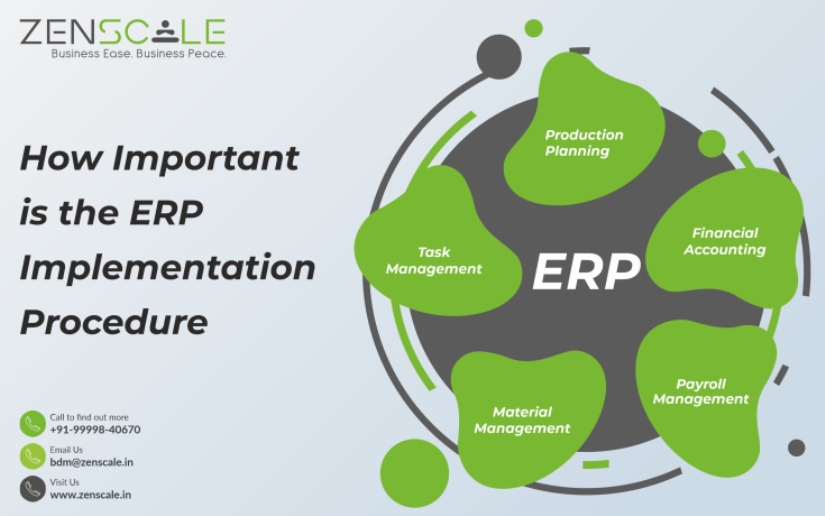"What is the use of a baby toy that does not rattle?"
Same is the case with ERP. Ever since the emergence of cloud solutions, Enterprises looking to gain agility and the power to grow are migrating to cloud-based solutions with evolving technologies in management. Benefits of ERP are no secret to anyone. These cloud systems provide accurate, real-time insight and the ability to work remotely. ERP adoption is an ambitious project for organizations looking to gain resilience and profitability via a robust organizational structure. However, a research has come to light that nearly 20% such adoptions fail to deliver what it was supposed to. This may happen for a variety of reasons but the one major responsible factor is undermining its implementation process. The success of the adoption rests on a diligent implementation.
What is the Purpose of ERP Implementation
Adoption of ERP is not just digitalizing or reducing paperwork. What we wish to gain defines the purpose of the implementation. It includes
Increase the operational proficiency of the business
Correcting the core pain areas vis-à-vis productivity, costs and inaccuracy
Gear up for Future benefits that the system will bring
Increase the ease of running
The project team must achieve all the above. Falling short of achieving even one of the above purposes brings the whole purpose to nought. That is why implementation assumes immense importance while adopting ERP.
The importance of each stage of the Implementation Journey
Studying the step-by-step procedure of ERP Implementation will make you understand how efficient handling of each stage is important.
Discovery – The First Stage
The marketing team in their consultations with the core client teams draws a complete profile. Based on this profile it outlines the key problem areas that need improvement and the objectives the client teams wish to achieve. The marketing team coordinates with the implementation project teams to take over and proceed further.
Need Assessment- The Second Stage
This is by far the most crucial stage. Assessing the client's software needs through meticulous analysis is an important part of the implementation. The team exercises analytical vision and expertise to achieve the best model for a particular company. Online and on-premise sessions are conducted with client teams to understand their working. The organizational flow is drawn and scrutinised to identify the key pain areas. For further improvisations, a set of questionnaires are provided to the users for extensive research to configure the ERP accordingly.
Data gathering & Verification- The Third Stage
A classified database is the essence of ERP. Data collection uploads the vital statistics of the enterprise in data form securely on-cloud from where it can be accessed by authenticated users without third-party intervention. It is a lengthy process but not for experienced implementation executives! If the software vendor lacks the diligence, this stage may waste too much time or effort and create errors in its progression. Methodical & hassle-free data collection is a must. At this stage, the required information is gathered module wise and categorically coded for upload. For inventory module the materials information, employees and HR policies for Payroll, and so on. Master files and ledgers are created and fastidiously verified before a one-time upload.
User training & Upload- The Fourth Stage
No matter how good your product is, the realisation of its full potential depends on the way it is used. Making a perfect model is as important as educating the core user teams unless you want to be talking to a brick wall.
Why implementations fail
Including unnecessary augments in the workflow - The deployment of the ERP system must not unnecessarily complicate simple procedures or activate a functionality that is not obligatory for a particular company. The practices that ease management, increase productivity and eliminate wastage and repetition must only be made operative.
- Lack of Expertise of Implementation Team - An experienced, expert, and structured team has a methodical approach. It's every member should be skilled in varied fields like purchase, accounts, HR, or production etc. and its leader must possess the ability to assert those skills in a coordinated fashion.
- It Becomes too Long - Some implementations take so long that it wears out the patience and the enthusiasm of the clients. We have heard of the process extending to months. This should never happen. A timeline needs to be followed and the various stages overlapped to carry out processes simultaneously. For example, once the infrastructure is set up, the training and data verification/upload is carried out at the same time using smaller teams.
- Lack of Commitment by Management - We know that the ERP projects require commitment from the employees involved in it, but the leadership must be equally engaged, if not more committed. Clear and frequent communication of the management and project members is a must for a successful collaboration.
- Insufficient Support in the Teething Periods - The implementation team should not only coach the users but also remain by their side in the initial period until they attain expertise. A reliable vendor always extends its services for user satisfaction.
- User Training has Flaws - Companies often complain that ERP is not showing them the visible results that were hoped for. On analysis, it is discovered that its employees are not even using most of the features and bypassing them for lack of knowledge. Professional training is again an important feature, often overlooked.
Conclusion
We saw how ERP implementations are important and its challenges require expertise that cannot be overlooked. The bottom line is a clear vision and understanding to carry the project successfully forward with seamless execution. The goal should be customer satisfaction and enterprise success.
